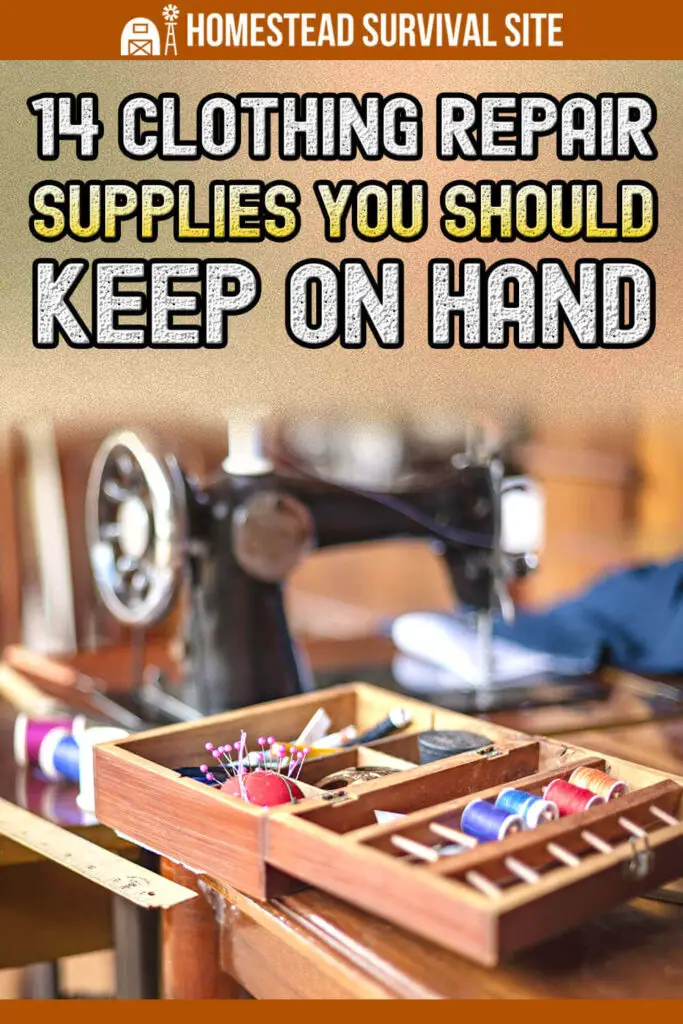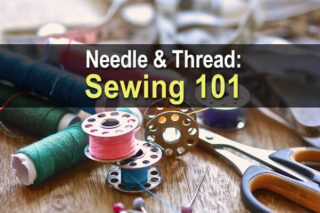Estimated reading time: 6 minutes
Life is rife with accidental catches, tears, and other clothing-destructive tendencies. Nothing is safe from the ravages of fencing, critters, or stray bush and tree branches, and even the sturdiest fabrics can be torn by a single catch. Thankfully, clothing is normally quite easy to repair and it only requires a few basic supplies to keep your clothing in functional and working order.
The average clothing repair, done immediately after damage occurs, should take less than five minutes and extend the life of the garment by several months or more. Most tear-related damages are easier to repair than wear related damages, as when something wears through the surrounding fabric is usually borderline giving away as well.
Something literally worn out will likely not be worth repairing, so only repair items where the damage is in otherwise sound fabric.
Want to save this post for later? Click Here to Pin It On Pinterest!
14 Items for Your Clothing Repair Kit
1. Sewing Thread – The most essential item for any clothing repair is a good quality sewing thread. Make sure to get thread that is suitable for hand-sewing. I prefer cotton thread. For most repair needs, if you have thread in navy blue, black, white, grey, and beige on hand, you will be set.
2. Unwaxed Dental Floss – On a homestead, you may need to repair jeans. For patching jeans, the actual strongest and best “thread” to use is unwaxed dental floss. The patch stitching will outlast the jeans. Only use on homestead jeans, as the stitching will be visible.
3. Sewing Needles – The next most essential item is your sewing needles. While there are a large number of different types and styles of needles, picking up a mixed case works well. At a minimum make sure you have quilting shorts as they are the most versatile type of sewing needle for clothing repairs.
4. Darning Needle – A second very beneficial needle to have on hand is a good quality darning needle. This is essential for repairing and darning knitted or woven items. Darning needles can go missing easily, so keep a few in your kit. They are also versatile if you need a high-heat holding needle for something like tick removal.
5. Assorted Buttons – Grandma probably had a button jar somewhere, but if you don’t have any buttons, it may be a good idea to get a mixed package from a thrift store. At the very least, save buttons from any and all clothing items that came with spares. Before you toss those worn-out button-down shirts, save the buttons, and maybe pick up a few generic, neutral tone, larger buttons that are suitable for pants, dress, or jacket repairs. Buttons always go missing, and are super easy to replace if you have a similar size and color one on hand.
6. Seam Ripper – Useful for cutting off buttons, opening and adjusting seams, and general deconstructive work, a seam ripper and stitch ripper set are very good to have on hand.
7. Scissors are essential for any clothing repairs, even if just to trim stray threads and cut out a new patch. You will want one pair of high-quality stainless steel scissors, only for fabric. A secondary pair of thread shears or embroidery scissors is also a good idea. An third, optional pair, is a set of stainless steel pinking shears.
8. Fusible Webbing – If you are not comfortable with hand sewing, you can get fusible webbing for patches. Simply cut out your patch, apply the webbing, and iron your new iron-on patch onto the garment. Make the patch more durable by sewing around it, but as a basic, the fusible webbing can help.
9. Mixed Fabric Pieces – You can’t patch a tear without fabric to make the patch. Save mixed fabric pieces, either new fabric that you have washed and prepared or remnants from cutting up used clothing. At a minimum, you want some denim fabric and some shirt weight material for miscellaneous patches. Patches don’t have to match the clothing you are repairing, and sometimes the most fun clothing repairs are the ones that can become a design element.
10. Crochet Hooks – If you wear knit sweaters of any kind, you will want to keep a crochet hook, or two, in your clothing repair kit. Use for picking up, and reknitting runs, weaving in the active yarn in a tear, and general useful repairs. Keep a few on hand, in the smaller sizes. These are easy to find at thrift stores.
11. Iron and Ironing Board – Most of us still have these hanging around. These are helpful for seam repairs, and hem repairs. While not strictly necessary, knowing that the fabric is perfectly flat and that everything is even is beneficial.
12. Ruler – Measure twice, cut once, also applies to fabric. Keep a metal ruler on hand to measure patches, or to measure the fold on hems to make sure the stitching is even. A metal ruler can be used in connection with the iron, so you don’t have to do as much pinning too.
13. Silk Pins – Pins, get a few high-quality silk pins, the ones with the colored tops. These are sharper than the average dollar store pin set, and won’t bend easily when stuck through multiple layers of fabric. Very useful for holding patches, new hems, or even buttons in place.
14. Optional – Get solid tone embroidery thread in a variety of colors and shades. If you have a lot of clothing in a wide range of specific shades, embroidery thread can help you have a matching repair thread easily on hand. However, if you keep your wardrobe fairly straight forward, color-wise, you may well be able to get by with the minimum of thread tones.
At the absolute minimum, consider keeping a handful of different tone threads, needles, buttons, and decent scissors on hand. While the other items are very beneficial, depending on what you are repairing, those four are the absolute minimum that you can do clothing repairs with. As you become accustomed to repairs and want to expand your abilities, you can always add in the other supplies.
Remember, particularly on a homestead, that accidents happen and a stitch in time will save having to do nine extra stitches later. Not to mention keeping homestead clothing in good repair will also help keep your non-homestead clothing tear and damage free.
Like this post? Don't Forget to Pin It On Pinterest!













For heavier work, a sewing awl with extra waxed thread is handy. It’s strong enough for repairing gear or footwear. I buy nylon thread (intended for upholstery work) for most of my repairs and gear making, and I think it cannot be broken. You could probably rappel with it in a pinch. I even have some Kevlar thread, but haven’t had a use for it yet. Thimbles can save your fingers when sewing heavier fabrics. If I can get get the math right at the bottom of the page I will post this.
I can remember my Mom sewing up holes in my Dad’s socks using this gizmo that looked like a wooden egg on a stick. She’d insert it in the sock and activate do a little weave. I also remember her switching the collars of his shirts. They’d get frayed at the fold. She’d simply loosen them and turn them over. He got twice the wear out of his shirts.
Some things I already have like a sewing kit. Other things I don’t so this has given me something to think about, and add to my already considerable prepping case.
I’ve added darning needles and I waxed, unflavored dental floss to my need list.